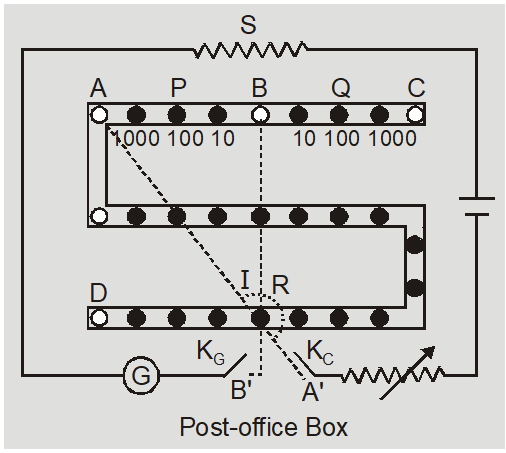A Post Office Box can also be used to measure an unknown resistance. It is a Wheatstone Bridge with three arms P, Q and R; while the fourth arm(s) is the unknown resistance. P and Q are known as the ratio arms while R is known as the rheostat arm. Post Office Box, Physics named it so because it has a shape of box and was designed to find resistance of electric cables and telegraph wires. It was used in post offices to determine resistance of transmission lines.
- At balance, the unknown resistance S = (P/Q) R …… (1)
- It is based on principle of Wheatstone bridge.
- Unknown resistance is $\mathrm{S}=\frac{\mathrm{Q}}{\mathrm{P}} \mathrm{R}$ and specific resistance is $\rho=\frac{\pi r^{2} S}{L},$ where $r$ is radius and $L$ is length of wire.
- In Post Office box we first press cell key and then press galvanometer key to eliminate induced effects.

- It is used to find unknown resistance, specific resistance of a wire, internal resistance of cell, resistance of galvanometer etc.
- A typical post office box is in a wooden box with a hinged lid and a metal or Bakelite panel showing circuit connections. Coils of wire are wound non-inductively, mounted in the body of the box, and have a negligible temperature coefficient. Pairs of ratio arms are each 10, 100, 1000 ohms. A resistance arm contains a number of coils from 1 to 5000 ohms with a plug for infinite resistance.
- Types and Effects of Electric Current
- Ohm’s Law and Resistance
- Combination of Resistances
- EMF and Internal Resistances of a Cell
- Cells Connected in Series, parallel and Mixed
- Kirchhoff’s Circuit Law
- Electric Currents in Conductors
- Wheatstone Bridge
- Post office Box
- Wheatstone Meter Bridge
- Moving Coil galvanometer
- Ammeter and Voltmeter
- Potentiometer Working Principle
